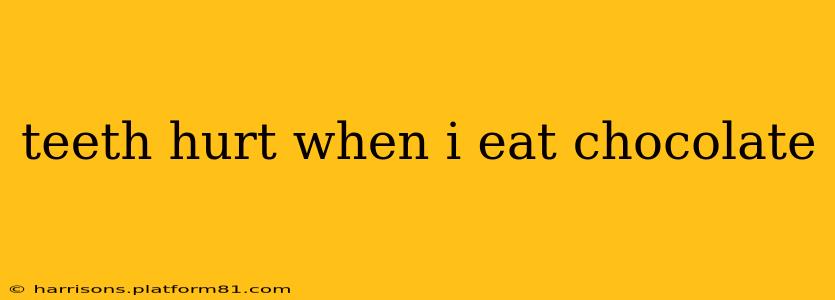Many people enjoy the delightful indulgence of chocolate, but for some, this sweet treat comes with an unwelcome side effect: tooth pain. If your teeth hurt when you eat chocolate, you're not alone. Let's explore the possible reasons behind this sensitivity and discover ways to alleviate the discomfort.
Why Does Chocolate Cause Tooth Pain?
Several factors can contribute to tooth pain triggered by chocolate consumption. It's not simply the sweetness; the texture, temperature, and even the ingredients can play a role.
1. Temperature Sensitivity:
Chocolate, especially when cold, can exacerbate sensitivity in teeth with exposed dentin. Dentin is the layer beneath enamel, and when enamel wears away due to erosion, brushing too hard, or gum recession, the dentin's nerve endings become exposed, leading to pain when exposed to temperature extremes. Cold chocolate is a common trigger for this type of sensitivity.
2. Sugar Content & Acidic Properties:
The high sugar content in many chocolates contributes to tooth decay. Bacteria in the mouth feed on sugar, producing acids that erode tooth enamel. This erosion can lead to cavities and sensitivity, causing pain when eating chocolate or other sweets. Furthermore, some chocolates contain acidic ingredients that can directly attack tooth enamel, worsening sensitivity.
3. Physical Texture:
The texture of chocolate, particularly crunchy or hard varieties, can trigger pain in teeth with existing cracks or fillings. The pressure exerted on sensitive areas can exacerbate discomfort.
4. Existing Dental Issues:
Underlying dental problems often worsen with chocolate consumption. These could include:
- Cavities: Decayed areas are particularly vulnerable to temperature and pressure changes.
- Cracked Teeth: Microscopic cracks can be aggravated by chewing, especially hard chocolates.
- Gum Disease (Gingivitis or Periodontitis): Inflamed gums are more sensitive and can easily be irritated by food particles.
- Recent Dental Work: Newly placed fillings or crowns might be sensitive to temperature or pressure for a short period after placement.
What Can I Do If My Teeth Hurt When I Eat Chocolate?
Addressing the underlying cause is key to relieving the pain. Here are some steps you can take:
1. See Your Dentist:
This is the most crucial step. A dentist can diagnose the root cause of your tooth sensitivity and recommend appropriate treatment. They might recommend:
- Fluoride Treatments: Strengthen enamel and reduce sensitivity.
- Desensitizing Toothpaste: Contains ingredients to block nerve endings in exposed dentin.
- Fillings or Crowns: To repair cavities or damaged teeth.
- Scaling and Root Planing: To treat gum disease.
2. Modify Your Chocolate Consumption:
In the meantime, consider these modifications:
- Choose Dark Chocolate (in moderation): Dark chocolate often has less sugar than milk chocolate.
- Eat Chocolate in Smaller Portions: Limit the amount you consume at one time to reduce the overall exposure to sugar and acids.
- Opt for Softer Chocolates: Avoid hard or crunchy chocolates that could put pressure on sensitive teeth.
- Consume Chocolate at Room Temperature: Avoid extremely hot or cold chocolate.
- Rinse Your Mouth with Water After Eating Chocolate: Help remove sugar and food particles from your teeth.
3. Practice Good Oral Hygiene:
Maintain a consistent oral hygiene routine:
- Brush Twice Daily: Use a soft-bristled toothbrush and fluoride toothpaste.
- Floss Daily: Remove food particles trapped between teeth.
- Use Mouthwash: Can help reduce bacteria and freshen breath.
How Can I Prevent Tooth Sensitivity from Chocolate?
Prevention is key. By following these tips, you can minimize the risk of tooth sensitivity related to chocolate consumption:
- Regular Dental Checkups: Visit your dentist for regular checkups and cleanings to detect and address dental problems early.
- Healthy Diet: Limit sugary and acidic foods and drinks.
- Proper Brushing and Flossing: Effective cleaning removes plaque and bacteria that cause decay.
By understanding the reasons behind your tooth pain when eating chocolate and taking proactive steps to address the issue, you can continue to enjoy this delightful treat without the discomfort. Remember, consulting your dentist is crucial for proper diagnosis and treatment.
